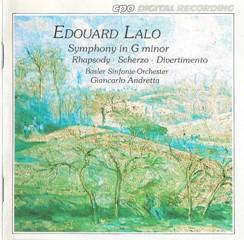Edouard Lalo: Symphony in G, Divertimento, Rhapsody, Scherzo (1995)
Edouard Lalo: Symphony in G, Divertimento, Rhapsody, Scherzo (1995)

Symphony In G Minor 1. I. Andante-Allegro non troppo 2. II. Vivace 3. III. Adagio 4. IV. Allegro Norwegian Rhapsody for Orchestra 5. I. Andantino. Allegretto 6. II. Presto 7. Scherzo for Orchestra in D minor. Presto Divertissement for Orchestra 8. I. Introduction (Andante)-Allegretto 9. II. Vivace 10. III. Andantino IV. Allegro con fuoco Basel Symphony Orchestra Giancarlo Andretta – conductor
Lalo was born in Lille (Nord), in northernmost France. He attended that city's music conservatory in his youth. Then, beginning at age 16, Lalo studied at the Paris Conservatoire under Berlioz's old enemy François Antoine Habeneck. For several years, he worked as a string player and teacher in Paris. In 1848, he joined with friends to found the Armingaud Quartet, playing viola and later second violin. Lalo's earliest surviving compositions are songs and chamber works (two early symphonies were destroyed).
Julie Besnier de Maligny, a contralto from Brittany, became his bride in 1865. She aroused Lalo's early interest in opera and led him to compose works for the stage. Unfortunately, they were deemed too progressive and Wagnerian and were not initially well received despite their freshness and originality. This led him to dedicate most of his career to the composition of chamber music, which was gradually coming into vogue for the first time in France, and works for orchestra.
Although Lalo is not one of the most immediately recognized names in French music, his distinctive style has earned him some degree of popularity. Symphonie espagnole for violin and orchestra still enjoys a prominent place in violinists' repertoire, and is known in many classical circles simply as "The Lalo". Lalo is also known for his Cello Concerto in D minor. The same Breton legend that inspired "Le roi d'Ys" also influenced, to some extent, his Symphony in G minor (a favorite of Sir Thomas Beecham) and various chamber works.
Lalo's idiom is notable for strong melodies and colourful orchestration, with a rather Germanic solidity that distinguishes him from other French composers of his era. Such works as the Scherzo in D minor, one of Lalo's most colorful pieces, might be considered appropriate embodiments of his distinctive style and strong expressive bent.
It was not till his late forties that Lalo gained fame as a composer. Le roi d'Ys (The King of Ys), an opera based on the Breton legend of Ys, is his most complex and ambitious creation. (The same legend inspired Claude Debussy to compose his famous piano piece, La cathédrale engloutie.) The opera was rejected for 10 years after its composition and was not performed until 1888, when Lalo was 65 years old. He was made a knight (chevalier) of the Legion of Honour in 1880. He died in Paris in 1892, leaving several unfinished works, and was interred at the Père Lachaise Cemetery.
About the Symphony in G:
This work was written in the same year as the popular Symphony in D minor of César Franck, and the two works have more in common than simply their coincidence in time. Both reveal strong influence from Wagner, and both are based on the development of a single motive and thus represent the cyclic form principle championed by Liszt. Unfortunately, Lalo's work has fallen into relative neglect, despite the efforts of conductor Sir Thomas Beecham. The work comprises four movements. It opens with an Andante introduction that presents the motto theme in minor mode. The Allegro non troppo that follows is based on two subjects, the first dramatic and rhythmic, the second tinged by wistfulness. The development is brief. The recapitulation is followed by a coda based on the motto of the introduction. The second movement, Vivace, is a rhythmic scherzo which in its core hides a moving, melancholic theme. Its development reaches tragic proportions, but the scherzo rhythm returns to lift the mood. The last section has a particularly incisive rhythm, but the closing brings an echo of the melancholic theme. The third movement, Adagio, is like an extended song. It opens with the strings in a pensive major mode, gradually leading to a peak of feeling. The second part of the movement brings a pastoral feeling, leading to a full-throated statement of the motto theme, after which the music dies out. The finale, Allegro, is a rondo with an peculiar rhythm suggesting a hopping march. The conclusion recalls the closing pages of the first movement and the motto theme, ending on a tragic note. --- ladiscotecaclasica.blogspot.com
download: uploaded anonfiles yandex 4shared solidfiles mediafire mega filecloudio nornar
Zmieniony (Poniedziałek, 27 Styczeń 2014 10:08)








